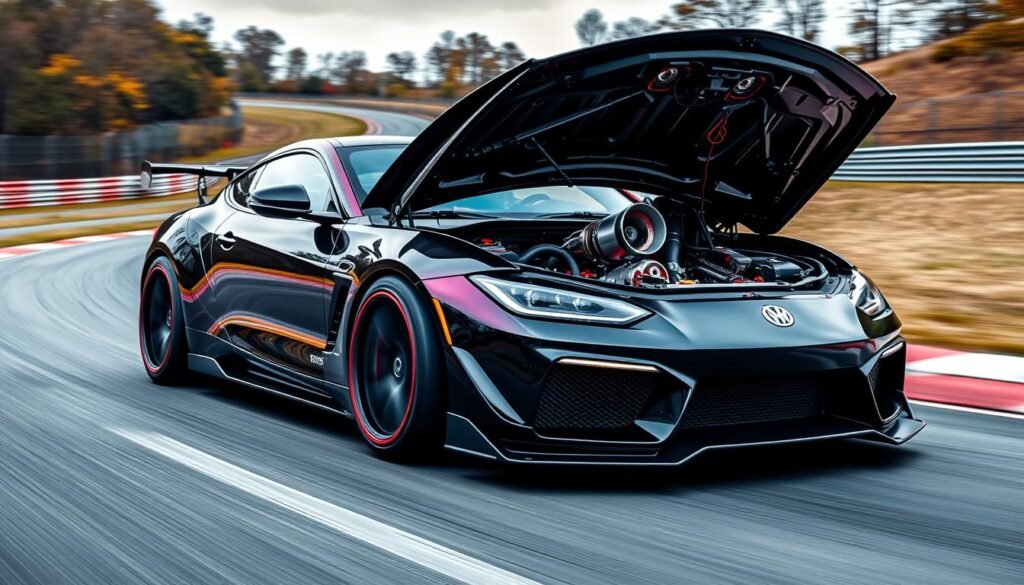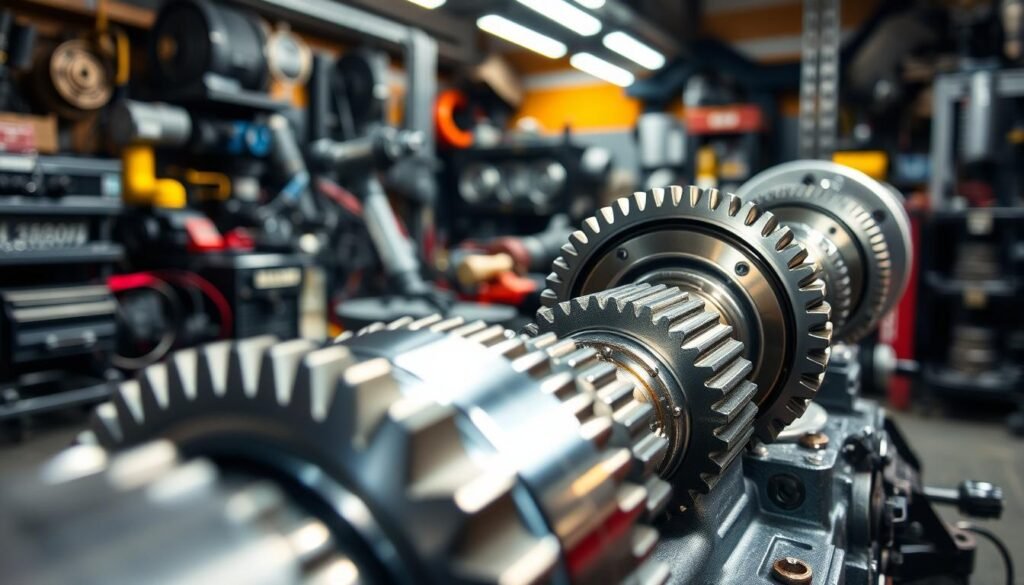In the world of car lovers, making cars go faster is a big deal. This article will show you how to make your car better. We’ll cover engine tuning and car changes, from the basics to the latest upgrades.

Key Takeaways
- Uncover the secrets of engine fundamentals and their impact on performance
- Discover the power of ECU remapping and performance-enhancing chips
- Explore the world of forced induction systems and their transformative effects
- Dive into advanced performance upgrades and modifications
- Understand the essential components for boosting engine efficiency and power
Understanding Engine Fundamentals and Performance Potential
To really get the most out of a vehicle, you need to know how its engine works. Most cars have internal combustion engines. These engines turn fuel’s chemical energy into the power that moves the car.
Thanks to engine remapping and ECU tuning, you can boost an engine’s performance. This makes the car go faster and run better.
Internal Combustion Engine Basics
At the heart of an internal combustion engine are cylinders. Inside each cylinder, a piston moves up and down. This movement draws in air and fuel, which is then compressed and ignited.
This ignition makes the pistons move back down. This motion turns the crankshaft. The energy from the crankshaft then powers the wheels, making the car move.
Power Output and Torque Dynamics
An engine’s power comes from its torque and speed. Torque is the twisting force, and power is how fast that force is applied. By tweaking the engine, you can boost both torque and power.
This means your car can go faster and perform better. Techniques like forced induction help achieve this.
Engine Components and Their Roles
The engine’s parts, like pistons and crankshafts, are crucial for its performance. Knowing how these parts work together helps you make the engine better. By upgrading or modifying them, you can get the most out of your engine.
“Proper engine tuning can unleash the true potential of a vehicle, transforming it into a thrilling, high-performance machine.”
Car Performance: Engines, Tuning, and Modifications
To get the most out of your car’s engine, you need to tune and modify it right. There are many ways to do this, like ECU remapping and using forced induction systems. These methods can make your car faster and more fuel-efficient. Let’s look at how to optimize your engine and make your car better.
ECU Remapping and Performance Chips
The engine control unit (ECU) is like your car’s brain. It controls things like fuel, ignition, and turbocharger performance. By changing the ECU settings, you can make your car more powerful and save fuel. Performance chips are easy to use and let you tweak your engine’s performance without much effort.
Forced Induction Systems
Turbochargers are a common way to boost your car’s power. They use exhaust gases to push more air into the engine. This means more fuel can be burned, leading to more power. Turbochargers work well with exhausts and cold air intakes to make your engine more efficient and quick.
Engine Management Systems
Modern engine management systems give you control over your engine. They monitor important details and adjust settings for better performance. These systems help your engine run smoothly, even when it’s pushed hard. By using these technologies, you can get more power and better fuel efficiency.

“Tuning your engine is like unlocking a secret treasure trove of power – it’s an exhilarating journey of discovery and performance enhancement.”
- ECU remapping can improve power, torque, and fuel efficiency.
- Turbochargers provide a significant boost in power output.
- High-performance exhausts and cold air intakes work in tandem with forced induction systems.
- Advanced engine management systems offer precise control and optimization.
Advanced Performance Upgrades and Modifications
Car enthusiasts looking for big power gains have exciting options. Upgrades like camshaft changes, nitrous oxide systems, and engine swaps can really boost your car’s engine power.
Camshaft Upgrades: Unleashing Power
Changing your engine’s camshafts can greatly improve its performance. The right camshafts can better control the engine’s valves, leading to more airflow and power. This is especially good for engines without boosters, adding a lot of horsepower and torque.
Nitrous Oxide Systems: Temporary Power Boosts
Nitrous oxide systems give engines a quick power boost. They mix nitrous oxide with fuel, increasing horsepower and speed right away. But, using them safely and correctly is key to avoid engine damage.
Engine Swaps: Maximum Performance Potential
For the biggest performance gains, swapping engines is the way to go. It lets you replace your car’s engine with a more powerful one. This upgrade is complex, involving changes to the engine bay and drivetrain. But, the results are worth it, offering amazing power and driving experience.
Exploring advanced upgrades and modifications needs careful planning and knowledge. By looking into camshaft changes, nitrous oxide systems, and engine swaps, car lovers can unleash their vehicle’s full potential.

| Upgrade | Impact | Considerations |
|---|---|---|
| Camshaft Upgrades | Increased airflow and power output | Compatibility with existing engine components, potential impact on engine reliability |
| Nitrous Oxide Systems | Substantial and immediate power boost | Proper installation, safety precautions, and impact on engine longevity |
| Engine Swaps | Unlocking maximum performance potential | Extensive modifications, compatibility, and installation complexity |
Essential Performance Parts and Components
To boost your vehicle’s performance, focus on key upgrades. High-flow exhaust systems, for example, improve engine efficiency by cutting backpressure. They also let air flow more smoothly. These systems, made from stainless steel or titanium, increase power and give a more aggressive sound.
High-Flow Exhaust Systems
Switching to a high-performance exhaust system unlocks your engine’s full power. These systems cut down on flow restrictions and backpressure. This lets your engine breathe better, boosting horsepower and torque. They also improve fuel efficiency and cut emissions, making them a great choice for those who love performance.
Cold Air Intake Solutions
A high-quality cold air intake complements your exhaust system. It brings cooler, denser air into the engine, boosting power and quickness. By swapping out the factory air box for a better design, cold air intakes reveal hidden horsepower and enhance engine performance.
Performance Camshafts and Valvetrain
The camshafts and valvetrain are crucial for engine performance. Upgrading to performance camshafts optimizes valve timing for better airflow and combustion. Strengthening the valvetrain with stronger springs and rocker arms lets the engine rev higher. This unlocks more power from your engine.
FAQ
What is engine remapping, and how does it improve car performance?
Engine remapping, or ECU tuning, changes the engine control unit (ECU) software. This tweak optimizes engine settings. It boosts power, speeds up acceleration, and saves fuel.
How do forced induction systems, such as turbochargers, enhance engine performance?
Turbochargers use exhaust gases to force more air into the engine. This lets the engine burn more fuel and make more power with each cycle.
What are the benefits of high-performance exhaust and cold air intake upgrades?
Upgrades like high-performance exhausts and cold air intakes boost engine power and efficiency. They let the engine breathe better and improve airflow. This leads to more power and better fuel use.
How can camshaft upgrades and nitrous oxide systems further boost engine performance?
Camshaft upgrades improve valve timing and lift, letting the engine breathe better and make more power. Nitrous oxide systems give a quick power boost by adding a nitrous and fuel mix to the engine. This increases power for short, fast accelerations.
What are some of the key considerations when swapping engines in a vehicle?
Swapping engines means replacing the factory engine with a more powerful one. It’s a big job that needs careful planning and lots of work. You have to make sure the new engine fits, cools well, and works with the car’s systems. Engine swaps can greatly improve performance but take a lot of time, effort, and money.
